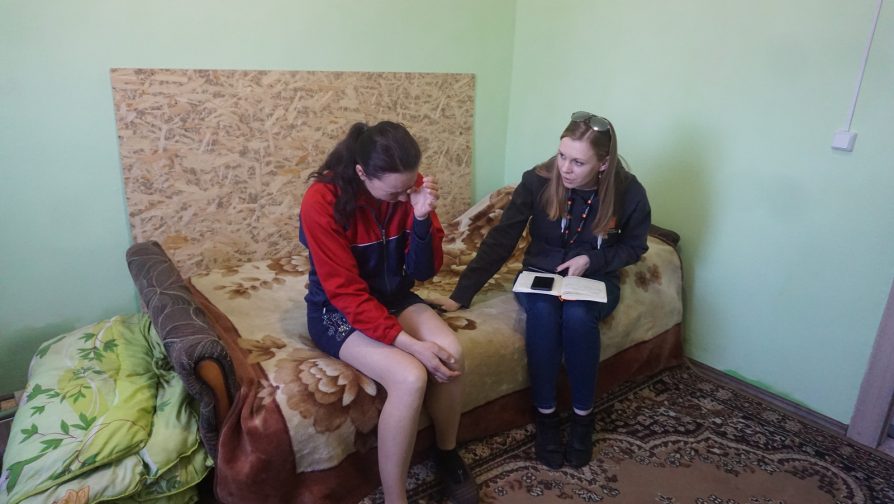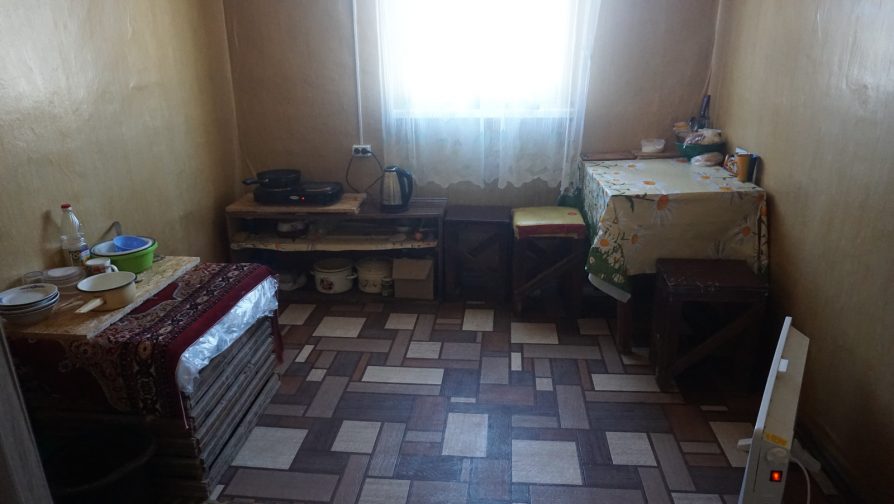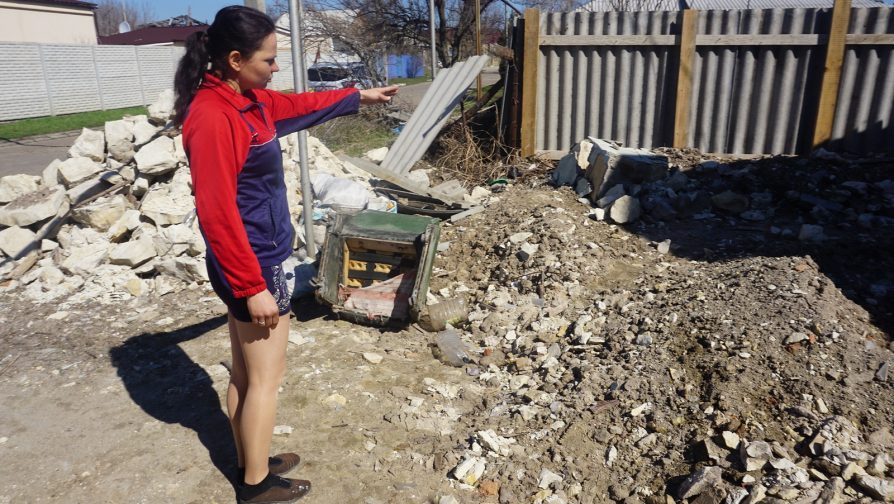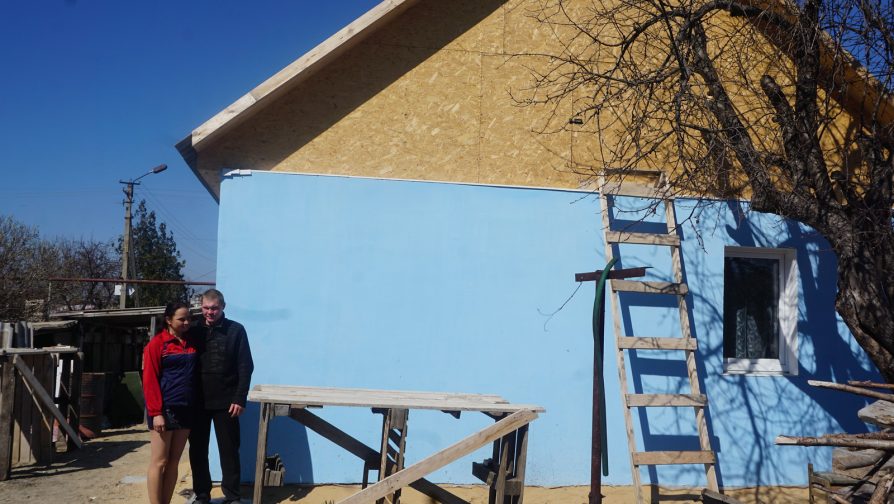House of Ihnatenko family in Stanytsia Luhanska was completely destroyed by shelling and later reconstructed by NRC with funding provided by the UNHCR. Overall, 692 buildings were reconstructed by the UNHCR in 2018.
Nina dreams of future without war. She believes in it. Nevertheless, the feeling of anxiety does not leave her.
© Nina dreams of future without war. She believes in it. Nevertheless, the feeling of anxiety does not leave her.
Nina, 36, a resident of the frontline town of Stanytsia Luhanska, cannot hold back her tears, remembering the most horrific episode in her life − the day when the family lost its home.
Before the outbreak of the armed conflict in eastern Ukraine, Nina’s husband, Vsevolod, 36, worked at a plant in the nearby city of Luhansk. Kyrylo, their son, who is 18 now, studied at a local school. Nina worked in the forestry sector. The family also managed greenhouses, like most residents in this rural area.

War through the window
In May 2014, hostilities erupted in Stanytsia Luhanska. Air strikes, heavy shelling and landmines became a terrifying reality for the family.
“The first shells fell 30 meters from our house. A neighbor died right in front of my son’s eyes. Shrapnel killed her,” recalls Nina.
However, they did not dare to leave, even when the town was engulfed in flames. They somehow stoically endured all these horrors. They hid in a small shed, spent nights in a neighbour’s basement, since they did not have one of their own.
Life without a roof
15 February 2015 − the day of the ceasefire announcement − became the most tragic one for the family. On that day they lost their home, amid late-night fighting.
“We were at our relatives, not far from our house. The artillery attack started, and we decided to wait and not rush home. When the shelling stopped, it turned out that we had nowhere to return to,” Nina says with tears in her eyes.
Two huge shells destroyed the house. One struck right in the children’s room. The family lost everything and were overwhelmed by a sense of emptiness, hopelessness and uncertainty.
“The only thing that comforted us was that all our relatives and friends were alive,” says Nina.

After the destruction of their home, the family moved to Luhansk, a city not under the control of the government, to live with Nina’s mother.
“We did not live in Stanytsia Luhanska for almost three years. From time to time, we used to come to visit the ruins of our house, because we were homesick,” notes Nina.
Building a new house
On the advice of her friends, Nina turned to the Norwegian Refugee Council (NRC), UNHCR’s partner for assistance and, in spring of 2018, construction began on a new house in Stanytsia Luhanska.
“We removed the remnants of the old house before we started building a new one with our own hands,” says Nina. With the help of friends and relatives, the family tried to do it as quickly as possible, since the construction materials had already been delivered by NRC. However, Nina realized that they could not handle such a complex task as building a new house all by themselves. They were also short on time.
“It was hard to find builders. There are not so many of them in the town, and those working at that time already had 5-6 houses to reconstruct and did not hurry to accept new offers. Finally, we found some. The builders poured concrete for the foundation, erected walls and constructed the roof; we did all the other exterior and interior work ourselves. Construction materials were provided in full. However, it was difficult to stay within the budget allocated to us, since prices were constantly increasing,” emphasizes Nina.
The family moved into their new house in early December 2018, six months after construction started.

“People, who really want and need something, will make every effort to achieve their goal. We got in touch with other locals, who were also rebuilding houses with the NRC support, observed each other’s construction work, and shared our successes,” smiles Nina.
There is still so much to do
Although the house has been rebuilt and the family is living in it, there is much more to be done. There is practically no furniture and household appliances in the house − everything had been destroyed on that horrible night in 2015.
“The full reconstruction project envisages the building of an absolutely new house − the so-called “box” − which, of course, also requires interior finishing, furnishing and appliances. Unfortunately, this is not a part of the project’s activity,” explains the NRC shelter project coordinator, Mykhailo Kyslynskyi.
Life goes on
Life has now become calmer in the town, although local residents still hear the sounds of gunfire and mine explosions almost every day. Furthermore, Nina worries about how the so-called “contact line” between government and non-government controlled areas divides her family. Nina and Vsevolod’s parents, relatives and some of her closest friends live in non-government controlled Luhansk.

Nina dreams of a future without war. She believes in it. However, a feeling of anxiety also haunts her.
“I do not want my son to live in constant fear. I want him to have the opportunity to start a family and raise his own children in a country at peace. Seeing my future grandchildren is the thing I want to do most,” says Nina.
The Ihnatenko family received assistance from NRC through funding provided by the UN Refugee Agency.
In 2018, within the frame of cooperation with the UN Refugee Agency, NRC fully reconstructed 23 destroyed homes in eastern Ukraine, 18 of which are located in Stanytsia Luhanska district. Additionally, NRC repaired another 333 houses that had suffered from light, medium or heavy damage.
Overall, UNHCR reconstructed 692 buildings in 2018.
Share on Facebook Share on Twitter